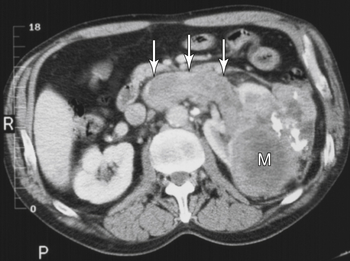∗In men younger than 50 years, epididymitis is commonly caused by sexually transmitted disease (chlamydial infection and gonorrhea). Treat accordingly. In men older than age 50 years, epididymitis is commonly caused by urinary tract infection (e.g., Escherichia coli). Treat with trimethoprim-sulfamethoxazole or ciprofloxacin. Painless hematuria (gross or microscopic) is the most typical presenting sign. Patients rarely complain of the classic triad of hematuria, flank pain, and a palpable flank mass. Computed tomography (CT) scan (preferred over intravenous pyelography) is a good initial diagnostic test (Fig. 38-1). Treatment for disease confined to the kidney or with extension limited to renal vein invasion (classic) is surgical resection. With other organ invasion or distant metastatic disease (usually to lung or bone), immunotherapy (e.g., interleukin-2) is the preferred treatment.
Urology
1 Cover the right-hand columns and specify the classic differences between testicular torsion and epididymitis. What imaging test can diagnose and distinguish these two conditions?
TESTICULAR TORSION
EPIDIDYMITIS
Age
Younger than 30 yr (usually prepubertal)
Older than 30 yr∗
Appearance
Testis may be elevated into the inguinal canal; swelling
Swollen testis, overlying erythema, urethral discharge/urethritis, prostatitis
Prehn sign
Pain stays the same or worsens
Pain decreases with testicular elevation
Treatment
Immediate surgery to salvage testis; surgical orchiopexy for both testes
Antibiotics∗
3 How is renal cell carcinoma diagnosed and treated?

Stay updated, free articles. Join our Telegram channel

Full access? Get Clinical Tree


